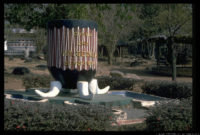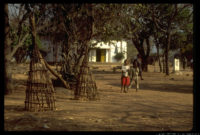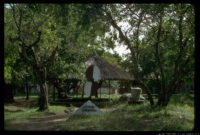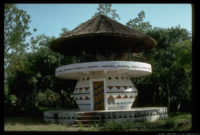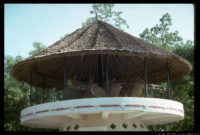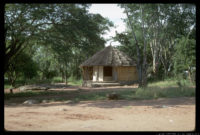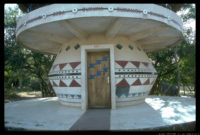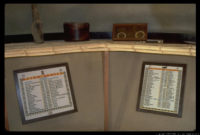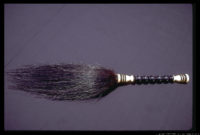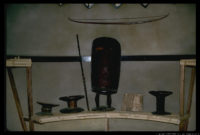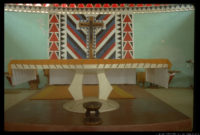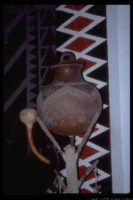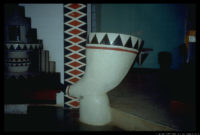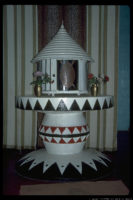by Aimee H.C. Bessire
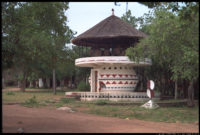
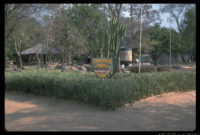
As the visitor approaches the museum entrance, after meandering along a wide path and passing the grade school, the village homes and shambas (farms) we see the brilliantly decorated administrative buildings and gift shop. A large, technicolor entry marker in the shape of an oversized royal drum welcomes us to the museum. The drum is positioned on top of a three dimensional, bas-relief map of Tanzania (complete with Lakes Victoria, Tanganyika, Malawi and the Indian Ocean) and is marked “Chama cha St.Sesilia” (the name of the local ethnographic society) with the names of four important Bujora dignitaries inscribed around the sides of the monument base: the Dutch Father Blomjous (Bishop of Mwanza Archdiocese); Hendricks “Chenya” (a Dutch Missionary of Africa and expert in Kisukuma); Butibubage (the Tanzanian Bishop who replaced Blomjous); and D. Klementi “Fumbuka” (the founder of the Sukuma Museum and Bujora Church, Father Clement, who was nicknamed “Fumbuka,” which means unexpected).
Exercising the “self-enclosure” and classification of the museum institution, the Sukuma Museum provides the visitor with a representation of Sukuma life. As we move through the museum, we are able to walk past and inside structures of traditional Sukuma history. The installations of the Museum are thematically organized with all facets of “traditional” Sukuma life represented: the royal, the sacred and the quotidian. The museum visitor is able to visit a representation of a traditional Sukuma house and compound, the thatched dwellings of a Sukuma blacksmith, a replica of a traditional doctor’s house and a Royal Pavilion for Sukuma royal history and Dance Society Pavilion for the history of Sukuma dance. Prominently situated at the far end of the compound, the Bujora Church is placed on the crest of the hill that overlooks the entire grounds and surrounding area of Lake Victoria.
A Short Tour of the Sukuma Museum
As we enter the Sukuma “homestead,” we are able to walk through a traditional style dwelling and view objects of daily life such as cooking utensils, religious objects and hunting and agricultural implements. Moving to the Balongo (blacksmith) house, a round structure thatched from top to bottom, we must duck our heads to enter the three foot high door. Once inside we can view the objects used by the Sukuma blacksmith, such as the cowskin bellows and large stones used during forging, as well as the agricultural hoes and spear heads that are made by the blacksmith. The next building on our tour is the Royal Pavilion where objects representing the history of the Sukuma royal families are exhibited. We will tour both this structure later in greater depth. Opposite the Royal Pavilion and near the Sukuma “homestead” is the Iduku, or traditional doctor’s house, where the objects used by different types of Sukuma healers are displayed alongside photographs of famous healers. This building is constructed of concrete, but is designed to replicate the shape and size of a traditional Iduku, a thatched conical dwelling. Objects such as medicine calabashes, protective medicinal horns, divination implements, flywhisks and doctor’s staffs are displayed inside the structure. Next on our tour is the Dance Society Pavilion, where we will hear about the history of Bagika and Bagalu, the competing dance societies, and see the costumes and objects used by many different dance groups within these societies. Much like the Royal Pavilion as we will see, this building is creatively fabricated and painted in bright white, blue, black and red.
The Royal Pavilion
The structure called the “Royal Pavilion” perhaps best illustrates the display tendencies of the Sukuma Museum. Ironically, the larger than life exterior of the Pavilion does not seek to replicate an “actual” Sukuma structure. A royal dwelling (ikulu) would resemble a traditional Sukuma homestead in shape, but would be set apart by its size and by the decoration of the roof pinnacle with shells and often an ostrich egg. At the Sukuma Museum, however, the Royal Pavilion resembles a large stool and serves as a symbolic demonstration of the Sukuma chief through the image of the royal throne.
The Pavilion, which serves as a structure for the display of royal regalia and provides a history of several Sukuma chiefdoms, consists of an enormous royal throne with a second story to house the royal drums. The image of the throne is repeated throughout the museum (as actual stools for games, as a logo and as sacred symbol in the church) and with repetition comes a certain presumed authority. The stool (isumbi lya itemelo in Kisukuma) serves as a symbol for the chief’s rule, and, as Hans Cory has suggested, the word for “chair” is closely linked to the idea of rulership (1951: 11). For example, to say “to take away from the chair” historically signified to “dethrone.”
On the first story, the viewer enters the “base” of the throne to view a collection of royal objects such as stools, fly whisks and crowns. There are also charts of royal lineage in several of the fifty-two Sukuma chiefdoms and the names of the chiefdoms are inscribed around the exterior of the Pavilion. Displayed on the upper level, which can be reached by a narrow, circular staircase, are royal drums that have been donated to the museum by local chiefs.
Isolo, the Sukuma Royal Game
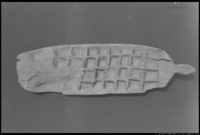
Next to the Royal Pavilion, a billboard sized map displays the fifty-two historic Sukuma chiefdoms). It is possible to determine the most powerful chiefs, by the amount of land depicted on the map. The billboard map asserts a historical authority and the continuity of royal tradition, which is further emphasized by its surrounding context. The map also serves as a backdrop for two bao (isolo in Kisukuma) games of poured and painted concrete, complete with royal stools, which museum visitors and guests are permitted to use. The juxtaposition of the map of Sukuma chiefdoms and the bao games (a game closely related to mankala in West Africa) provides a narrative suggesting the peaceful battles (perhaps mythical) between chiefs through the playing of bao for land. It has also been suggested that bao was played as a means of appropriating lands up until the time when the German colonizers arrived in Tanganyika. The chief who lost would forfeit half the land in his chiefdom. The less-successful a chief was at bao, the smaller his
or her chiefdom. This installation documents the history of Sukuma chiefdoms while at the same time mythologizing royal lineage and chiefly hierarchy.
The Design of the Museum
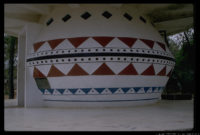
Color abounds at the museum as an embellishment of a Sukuma village. The exterior of the Royal Pavilion, the Dance Society Pavilion and the Bujora Church are decorated with a bright red, blue and black triangular pattern against a white background. Father Alex Mugonya, the current Bujora parish priest, suggested that the triangles painted throughout the Museum and Church represent the hoe, a symbol of life, death and the cycle of life in Sukuma tradition. He further noted that the red, black and blue color triad represents the life of the people of the Lake Victoria region, with red as life and fire, black as the people, and blue signifying water, specifically Lake Victoria. He also suggested that for the Sukuma, the hoe signifies an implement used to sustain life through cultivation and to acknowledge death, through burial. Yet the repeated triangular forms also suggest the Catholic Trinity of God the father, son and holy spirit. The triangular sign thus simultaneously provides a recognizable representation of the cycle of life and death through the Sukuma hoe, as well as life, death and resurrection cycle of the Holy Trinity for the Church.
The use of bright colors adorning much of the Sukuma Museum architecture might be misleading to the visitor, suggesting that such painting is an indigenous tradition. Traditional painting forms are quite different and painted architectural structures are rare within the Sukuma area. Bright designs incorporating the triangular form are also replicated on the exterior of the administrative buildings as well as the Sukuma Archives and serve as a means of demarcating the Museum space.
The Bujora Church
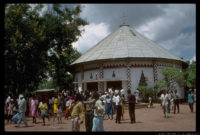
The exhibition of royal history is further exemplified by the appropriation of indigenous symbolism in the church and equation of the church with a royal structure. Much like a chief’s dwelling, the church, which is the largest of all the structures at the museum, is also situated in a prominent position. The large, brilliantly colored church bears a striking resemblance to a Sukuma royal dwelling. Much like the chief’s house, the church possesses a hoe and shell decoration at the roof pinnacle which symbolizes the dwelling of an individual of high standing. The royal symbolism of the Sukuma church equates God with a Sukuma chief and acknowledges that the traditional Sukuma chief is father of his village.
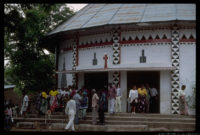
Inside the Church, the Sukuma worshipper is confronted by a series of indigenous symbols which have come to represent Christianity to the local population. The cross behind the altar is surrounded by the same tri-color hoe-symbols of the cycle of life that are used on the building exterior. Many of the signs utilized in the church interior reflect simple messages about the significance and magnitude of the Christian object in the liturgy. While royal icons play a large role in explaining the symbolism of the Catholic ritual, other explanations are made through everyday objects. Instead of evoking awe and respect through royal symbolism, the calabash used as a baptismal font provides a clear understanding, in culturally-specific Sukuma terms, that this is a container for water. In most Sukuma households, water is stored in similar calabashes. The only suggestion that this water is perhaps different from that of the everyday house is its placement on the stand rather than hanging from the ceiling or walls. The Altar is in the form of a royal throne, as noted earlier this is one of the most revered items in the chief’s regalia traditionally inherited from previous generations as a symbol of authority and power. The power of the throne cum altar suggests a link between respect for the chief, symbolized by the stool and reverence for the altar as a form of communion table. In addition, the pulpit takes the shape of an oversized bugle-horn, symbolizing both chiefly communication and the conveyance of a message, to be understood as the “word of god”. Such iconography evokes a simple understanding of the place where the message was to be delivered. For those who worship Sukuma traditional religion, horns are also used as containers for medicines used to protect and empower the individual.
Similarly, the tabernacle also provides a series of signs to suggest the function of the object. Yet here both aspects of the miniature and the gigantic are employed in the depiction of the “royal”. A miniaturization of the church (and therefore a royal dwelling) rests on an enlarged chief’s throne. The tabernacle recalls the Royal Pavilion with its two story structure of a dwelling on top of a chief’s throne. The tiny “church” is complete with a chief’s shield on the door, another indigenous sign of authority. The door itself suggests containment and the overall structure can be regarded as a chief’s dwelling, or royal container, and at the same time as a church or container of the sacred. This also suggests the function of the tabernacle which is the containment of the eucharist, or symbolic body of Christ. Here again, there is the equation of God and chief.
Father David Clement and the Sukuma Research Committee
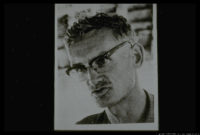
The Sukuma Museum reflects the research work of the Sukuma Research Committee, the Bana Sesilia, as well as Father David Clement’s philosophies concerning the collection of information and part of the colonial legacy of culture collecting. Museums are largely a colonial phenomenon in Africa, as well as on other formerly colonized continents. Today, many of these museums carry on the tradition as it was passed down from previous generations of museum collectors. Yet, unlike other African museums organized during the colonial era, where indigenous populations were “not included in visiting status and were actively discouraged from patronizing the museums,” the Bujora Museum was designed to preserve Sukuma culture for the benefit of the Sukuma visitor (Dawson Munjeri. 1991. Refocusing or Reorientation? The Exhibit of the Populace: Zimbabwe on the Threshhold. Exhibiting Cultures: The Poetics and Politics of Museum Display. Ivan Karp and Steven D. Lavine, eds. Washington and London: Smithsonian Institution Press, 446.). Although western tourists now make the long journey from Mwanza to visit the museum, the Bujora Museum was intended to benefit Sukuma individuals and inform them of their cultural heritage. Today, however, economic crises at the museum have necessitated an increase in the need for financial support from the tourist audience. Travelers can stay at the Bujora Cultural Center, a part of the Sukuma Museum, in small rooms, or in one of three replicas of the thatched traditional blacksmiths dwelling. There is also a large camping site for backpackers who wish to camp.
To realize his ambition to utilize autochthonous symbolism in the church, Father Clement proposed that “one required a thorough knowledge of the local environment through very close observation and analysis; in short by research into local customs, crafts and musical rhythm.” (Clement, 1977, “The Research Committee at Bujora,” Tanganyika Notes and Records , 81-82, 1977: 75.) In an attempt to extract himself as an outsider from actual research and to involve local individuals, he organized a team of indigenous Sukuma to serve as the Bana Sesilia (People of St. Sesilia) and the Sukuma Research Committee.
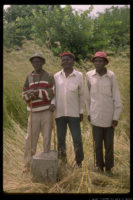
By engaging local residents in their own culture, Father Clement attempted to turn the tables on what James Clifford and others have called the “salvage paradigm,” a western attempt to record and save a non-western culture which might lose its primitive appeal or exotic nature to the winds of modernity. Yet, Father Clement’s position as ethnographer is complicated; for although he endeavored to place the data collection in the hands of the indigenous culture, it was in the end partially his own selection of the material research that went into the creation of the church and museum. In the end, this “predicament of culture” is not about removing culture from its context and displaying it before a usually disconnected audience where issues of self and other are inherent in the politics of display. It is instead a question of Father Clement’s negotiation of the ethnographic materials and his portrayal of Sukuma culture before a Sukuma audience.
Today, as a cultural center, the Sukuma Museum has continued on as a “living” museum and it is arguable that it now permits a constant writing/rewriting of the narrative of Sukuma history. The structures of the Museum remain a constant reminder of a historical moment of Sukuma culture and the Sukuma Museum serves as a cultural base for Sukuma individuals from all over Tanzania.
Contact Aimee H.C. Bessire: mbessire@meca.edu
